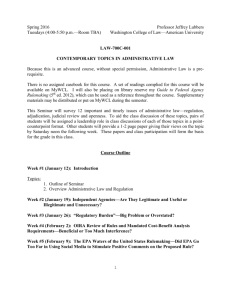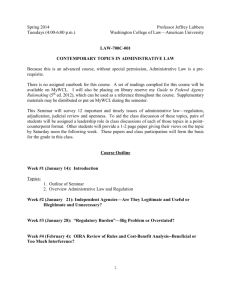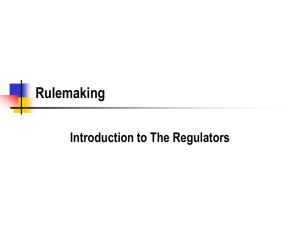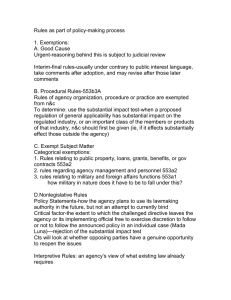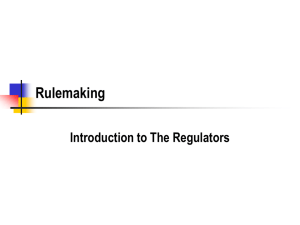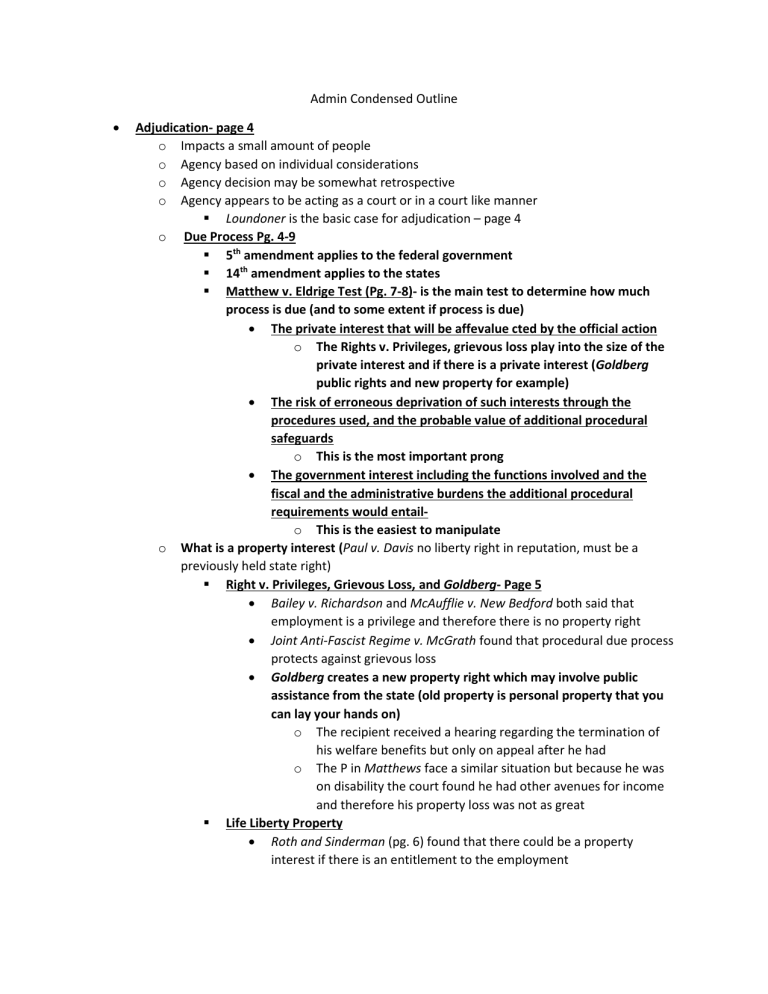
Admin Condensed Outline Adjudication- page 4 o Impacts a small amount of people o Agency based on individual considerations o Agency decision may be somewhat retrospective o Agency appears to be acting as a court or in a court like manner Loundoner is the basic case for adjudication – page 4 o Due Process Pg. 4-9 5th amendment applies to the federal government 14th amendment applies to the states Matthew v. Eldrige Test (Pg. 7-8)- is the main test to determine how much process is due (and to some extent if process is due) The private interest that will be affevalue cted by the official action o The Rights v. Privileges, grievous loss play into the size of the private interest and if there is a private interest (Goldberg public rights and new property for example) The risk of erroneous deprivation of such interests through the procedures used, and the probable value of additional procedural safeguards o This is the most important prong The government interest including the functions involved and the fiscal and the administrative burdens the additional procedural requirements would entailo This is the easiest to manipulate o What is a property interest (Paul v. Davis no liberty right in reputation, must be a previously held state right) Right v. Privileges, Grievous Loss, and Goldberg- Page 5 Bailey v. Richardson and McAufflie v. New Bedford both said that employment is a privilege and therefore there is no property right Joint Anti-Fascist Regime v. McGrath found that procedural due process protects against grievous loss Goldberg creates a new property right which may involve public assistance from the state (old property is personal property that you can lay your hands on) o The recipient received a hearing regarding the termination of his welfare benefits but only on appeal after he had o The P in Matthews face a similar situation but because he was on disability the court found he had other avenues for income and therefore his property loss was not as great Life Liberty Property Roth and Sinderman (pg. 6) found that there could be a property interest if there is an entitlement to the employment o o Basically if there is termination during a K, if there is a tenure or de-facto tenure system, then there may be a property right to employment (If there is an entitlement to the employment then there can potentially be a property right in the employment) Loudermill (pg. 8) found a property interest in employment of a civil servant o Court here required some kind of hearing prior to discharge of an employee when there is a constitutionally protected property interest Castle Rock found where the government has discretion to provide the benefit to provide the benefit then there is not a protected interest Ingraham v. Wright court defers to the legislative judgment, ruling that corporal punishment in schools does implicate a constitutionally protected property interest but that state C/L remedies are adequate protection o Goss v. Lopez (pg. 9) presents us with a Goss type hearing which is a basic hearing, at least some form of rudimentary precautions against unfair or mistaken finding of misconduct James Daniel Real Property found that a house is a property interest and that an ex parte hearing was insufficient process Formal Adjudication- S. 554 S. 556 S. 557 The magic words that trigger formal adjudication are A HEARING ON THE RECORD- Pg. 10 The record provides something for judicial review A statutory requirement that there be a public hearing is insufficient in the majority of jurisdiction (Sea Coast it is sufficient) Chemical Waste Management (Pg. 10) stands for the proposition that the presumption is for an informal and deference to agency determination of informal or formal proceedings Requirements for formal adjudications (per 554) (pg. 9) o An impartial and unbiased presiding officer o Notice and opportunity to participate o The right of parties to appear with counsel o Right to present oral and written evidence (including rebuttal) o Right to conduct cross examination o The right to submit proposed findings, conclusions, and exceptions o The compilation of exclusive record upon which the agency must base it’s decision o Limitation of ex parte communication The rules of evidence do not necessarily applicable under the APA A preponderance of the evidence is sufficient standard of proof to make a determination under formal adjudication (Steadman v. SEC pg. 11) A adjudicator can perform both duties as a finder of fact and concluder of law as long as both task are performed separately and separate findings of fact and law are issued (Withrow v. Larking pg. 11) Bias- Antonia v. SEC (pg. 12) found that an SEC commish had abuse his discretion for him not to recuse himself from an adjudication after making biased statements in public prior to the conclusion of the adjudication Non-Delegation Clause (Pg. 12) o Basic rule behind the non-delegation clause is there has to be clear, intelligible principle of general policy and standards The agency refine rules but cannot define them Intelligible principles is very broad, the limits are if instructions are vague and broad If all goals, purposes, and factors are laid out than this works up to an intelligible principle (only twice in the 30s has an agency not been upheld) – congress has a ton of leeway o Whitman Trucking (pg. 13) Congress must lay down by legislative act an intelligible principle to which a body authorized to act is directed to conform o The Amtrak cases provide that powers cannot be delegated to a private entity, must be a public entity SCOTUS held that Amtrak was a public entity (despite congressional pronouncement to the contrary as congressional pronouncements are not binding or authoritative) Arbitration looks private but can be public Rulemaking (pg. 15) o Nat’l Petroleum Refiners Assn states the agencies have the choice between rulemaking and adjudication (agencies prefer rulemaking) Reasons is because it’s more efficient (time and money) more fair, provides better clarity, and provides broader input as more people are involved Rulemaking has to be prospective, cannot be retroactive ( o Formal is covered by S. 553, 556, 557 On the record, nearly trial like way to engage in rulemaking, rarely encountered today Formal rulemaking is not required for an after hearing requirement in the organic statute (U.S. v. Florida East Coast RR pg. 17) o Informal S. 553 and S. 555 – Notice and comment rulemaking, less formal than trial Notice shall have general notice in the federal register, making the rule published (this is the notice) Statement of the time, place, nature of public rulemaking proceeding Reference to the legal authority of the proposed rule Either the terms of substance of proposed rule S. 555 provides the comment requirements “agency shall give interested parties an opportunity to participate in the rule making through submission of written data, views, arguments, etc.” i.e. comment Logical Outgrowth Test (Pg. 15) Deal with notice and the notice is adequate if the changes to the original plan “are in the character of the original scheme and the final rule is a logical outgrowth of the notice and comment already given o Notice is adequate if The final materially alters the issues involved in the rulemaking Or it substantially departs from the terms or substance of the proposed rule o Chocolate Manufacter’s Assn (pg. 15) found that chocolate milk being pulled off the approved WIC list without additional comment was not in the logical outgrowth of the proposed rule under notice and comment because Chocolate milk was originally on the list Concise General Statement (US. v. Nova Scotia Food Products Corp) o In Nova Scotia the court found the promulgated rule “arbitrary and capricious” because the agency failed to consider the economic impact of the the rule, nor did they make the data available for judicial review (the how and why) Needs to identify major issues of policy and explain why the agency resolved them in the ways that it did o Courts should be able to determine how the agency defined the relevant issues (i.e. a reasoned explantion) Agency explanation should identify f acts or policy that support the decision (discussed in U.S. Tankers v. Dole) o This need not be exhaustive but needs to explain the why Court should be able to determine how the relevant issues are defined by the statute (Automotive Parts and Accessories v. Boyd) Non-Rule Rulemaking and Non-Legislative Rulemaking Do not need notice and comment for this General Statement of Policy (Mada-Lua) o An agency’s announcement of their tentative intentions for the future. Does not establish a binding norm and cannot be relied upon as law. Can be repealed and superseded without notice and comment Interpretative Rule (American Mining Congress) o Agency interpreting an already previously promulgated rule, no notice and comment needed Vermont Yankee (pg. 17) stands for the proposition the courts cannot impose additional procedural requirements for agencies that are not in the APA Agency procedure comes from the constitution or the APA- agencies are generally free to fashion their own rules of procedure , and courts may not second guess these sorts of agency decisions Judicial Control of Agency Choice (pg. 18) Chenery states that courts must judge the propriety of agency action solely on the grounds invoked by the agency o Courts cannot substitute what it considers to be adequate and proper basis o The basis for agency action, however, must be clear so that courts are not compelled to guess at the reasoning underlying agency action o Agencies are free to choose between rulemaking and adjudication, and have a lot of discretion in choosing between adjudication and rulemaking (Heckler v. Williams pg. 19) Rulemaking has to be prospective (Wyman Gordon) and agencies are not precluded from announcing new principles in an adjudication proceeding) Distinction between Public and Private Rights (Pg. 19) Private Rights litigated between parties Public rights are conferred by the government Marathon Pipeline stated three principles (Pg. 19, bery formalistic) o Private right suits may not be adjudicated by agencies o Public right suits may include litigation between private individuals based on statutory claims by congresss o Non- Art III (adjunct courts), including administrative agencies, must be so limited to “the essential attributes” of judicial power retained by Art. III courts Test to determine between Art III courts and adjudication (from Schor pg. 19) o Consider the extent to which essential attributes of Art. III court are (should be) reserved to them? Question is how much the agencies look like a court? The agency can adjudicate narrow issues related to claims and conduct arising out of the agency legislation (i.e. public rights) o Consider the origins of the rights? Three traditional exceptions to Art III courts Territorial Courts Court martials and military courts Sovereign Immunity o All three of these are outside of courts created or mentioned in Art. III o Consider the congressional concerns that motivated deviations from the traditional scheme o In short it is OK for non-art III courts to handle private rights if they are narrowly related to the public rights at issue In Stern v. Marshall (pg. 20) the court says Art. III prohibited the state law tortious interference claim from being litigated in a bankruptcy court because the state law claim was not closely integrated into the bankruptcy claim the Legislative Veto (pg. 20) o Congress cannot overturn an agency adjudication through a legislative veto (overturn am executive decision via a singular legislative action o In INS v. Chada Congress possessed a legislative veto that could override a suspended deportation proceeding Problem is it is a violation of SOP for two reasons (pg. 21) Bicarmalism requires both houses to be involved for a veto (where only one sub-committee in one house acted here) Presentment to where a veto must be presented to the executive (not here) Appointments (pg. 21)- N&P clause and Appointments clause o Appointments clause (Art. II S. 2 Cl. 2) provides that the president can appoint, with advice and consent of the Senate, …….appoint all other officers (ones established by law) Officers does not include all employees, only ones that exercise significant authority (includes both principle and inferior officers) o Buckley v. Valeo dealt with a statutory scheme where 6 members of the FEC board, 2 were appointed by POTUS, 2 were appointed by the speaker of the house, and 2 by the senate Court said this violates the SOP as congress is precluded form vesting the power of appointment in itself- Congress can’t appoint officers of the United States Removal (pg. 22-24) o The power removal is incidental to the power of appointment (Myers v. U.S.) o The President can remove Principle officers who perform purely executive functions o Congress can place limits on the removal of officers who perform quasi-legislative and quasi-judicial functions (Humphreys’s Executor pg. 22) For example good cause o For Inferior Officers Myers, as read through Morrison tends to suggest the president’s unfettered ability to remove purely executive officers exists only when removal restrictions impede POTUS ability to faithfully execute the law (i.e constitutional duties) Morrison v. U.S. page 23 gives a four part test to determine an inferior officer o Is the officer subject to removal by a higher executive branch o Does the officer only have certain, limited duties o Is the officer’s job limited in jurisdiction o Is the officer’s job or the officer limited in tenure Edmond gives an alternative approach to whether one is an inferior officer o Whether one is an inferior officer depends on whether one has a superior Free Enterprise Fund (pg. 23) said two layers or more of for cause removal restrictions for officers exercising significant governmental authorities Judicial Review (pg. 24-28) S. 706 o S. 706 (pg. 24) provides says “a reviewing court shall decide all relevant questions law, interpret constitutional and statutory provisions, and determine the meaning or applicability of the terms of agency action. Court can do two actions Compel agency action Hold unlawful and set aside agency findings, conclusions, and functions o This can be based on judicial findings that the agency acted in a manner that is Arbitrary and capricious, and abuse of discretion, or otherwise not in accordance with the law Unsupported by substantial evidence o Court shall review the record on the whole Universal Camera Corp (pg. 24) the precise way in which courts interfere with agency action is not based on words in the standard of review but rather in the mood of how much deference Substantial evidence standard of review is more deferential than clearly erroneous but less deferential than a jury determination of fact Substantial evidence means the whole record is reviewed o State agencies are de novo review and state courts are not bound by state agency decisions (Jewish Hospital pg. 24) o Scope of Review of Law (pg. 25-26) Skidmore, Chevron, and Mead Skidmore (pg. 25) announces a standard of review that allows for a fair amount of deference to the administration in a totality of the circumstances type test Basically the court can allow the amount of deference they want Chevron (pg. 25) gives a two step approach to agency interpretation Has congress spoken to the precise issue in question (i.e. is the statute ambiguous) o If the congressional intent/statutory language clear and unambiguous then the agency get not deference If the statute s ambiguous then is the agency interpretation reasonable in light of the underlying law? o For reasonableness a court may not substitute its own construction of a statutory provision for a reasonable interpretation made by an agency o Chevron is a high level of deference Mead (pg. 26) involves Chevron step zero which first determines whether an agency even gets Chevron deference or does Skidmore apply? Chevron does not apply where there is no express authorization for rulemaking by congress o Non-legislative rulemaking (i.e. interpretive rule) will get Skidmore (less than Chevron) Examples include policy statements, agency manuals, enforcement guidelines o Scope of Review of Exercises of Discretion i.e. What is a hard look (pg. 26-28) Hard look is arbitrary and capricious in the context of agency policy making? Overton Park (pg. 26-27) stands for the proposition that to survive an arbitrary and capricious review a court o Considered all relevant factors and o Offer a plausible explanation for the decision o Agency must show its work via a plausible explanation using relevant factors State Farm (pg. 27) lays out a four part test for arbitrary and capricious review o Did the agency rely on factors congress did not intend the agency to consider o Did the agency entirely fail to consider important aspects of the problem? o Is the agency decision inconsistent with the evidence? o Is the agency decision so implausible that it could not be ascribed to a difference in view or the product of agency expertise State farm also states that the agency must examine all relevant dayta and articulate a satisfactory explanation including a rational connection between the facts found the decision made Brand X (pg. 27) states that a court’s prior judicial construction trumps an agency construction otherwise entitled to Chevron deference ONLY if the prior court’s holds that it’s construction follow from unambiguous teerms of the statute and there is no room for agency construction o Can be no gap for the agency to fill o Preclusion (pg. 28) In order to preclude judicial review congress must explicitly preclude judicial review (Johnson v. Robinson pg. 28) Consitutional issues cannot be precluded though, only review of agency decision Has to be explicit, courts are not big on implied preclusion, if congress wants to preclude judicial review then it needs to be explicit Standing (pg. 28-31) o Standing under S. 702 of the APA can be achieved if a P can show that They have suffered a legal wrong because of the challenged agency action OR o o o o o o That they are adversely affected or aggrieved agency action within the meaning of the zone A plaintiff must meet both the constitutional and prudential requirements for standing Three part test for constitutional standing from Lujan v. Defenders of the Wildlife (pg. 28-29) Plaintiff must have an injury in fact Must be concrete and particularized and imminent, cannot be speculative There must be a causal connection between the injury in fact and the conduct complained of The injury has to be fairly traceable to the conduct complained of and cannot the be result of independent action of a 3rd party before the court The injury must be likely, rather than merely speculative, redressed by a favorable court decision Past exposure to illegal conduct does present a case or controversy unless unaccompanied by continuing adverse effects. In FEC v. Akins (pg. 29) the court said non-disclosure of campaign contributions was a particularized and concrete injury because more information equals a better electorate For Taxpayer standing (has never been extended beyond the Establishment Clause) The taxpayer must establish a logical link between the and type of legislative enactment attached Has to be a exercise of the of taxing and spending clause The taxpayer must show the challenged enactment exceeds the constitutional limitis of the taxing and spending power and not simply beyond the powers delegated to congress Prudential Requirements mean the challenging party is within the zone of interests congress had in mind in enacting the statute Two part analysis for Prudential standing (pg. 29) Analyze the statutory provisions at issue to identify the interests arguably to be protected by provision Determine whether the P’s interests affected by the agency determination are among those to be protected by the statute NCUA (credit union case pg. 31) is the high water mark for prudential standing Proper inquiry is if the interest sought to be protected by the complainant is arguably in the zone of interest protected by the stautute o Have to show that congress generally had you in mind when formulating the statute Chicago Junction (pg. 29)- Private entity can have standing through the public interest Alabama Power (pg. 29)- Injury of competition was not within zone of interest of a statute subsidizing power Air courier (pg. 30) –Loss of jobs not in zone of interest, only revenue So while the Ps did suffer an injury and fact and met the constitutional requirements, they fell short of the prudential requirements Ripeness, Finality, and Exhaustion (pg. 31-34) o Ripeness (pg.31-32) Two part test for Ripeness from Abbott Labs (pg. 32) Fitness for judicial review o No questions of fact remain to be decided It’s a purely legal question remaining and the record for judicial review already exists Hardship to parties for withholding judicial review In Abbott Labs the case was ripe and in Toilet Goods the case wasn’t ripe (bot cases pg. 32) o Finality (pg. 32-33)- about what the agency does S. 704- As a general matter two conditions must be met for agency action to be final Two part test for finality o Action must mark the consummation of the agency’s decisionmaking process Cannot be merely tentative or interlocutory nature o Must be an action from which legal consequences will flow or form which rights or obligations have been determined Sometime agency inaction can be a final action for the purposes of finality under the APA o Exhaustion (pg. 33-34)- about what the litigant does Generally a court wants you to exhaust prescribed administrative agencies before seeking judicial review Cts. want Ps to jump through the administrative hoops Three general exceptions to exhaustion (pg. 34) If administrative remedies would be inadequate because of questions of agency jurisdiction If there would be any undue bias by the agency If the administrative procedure would take such an amount of time as to amount to undue prejudice
